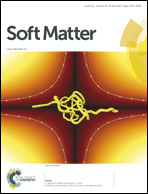Designing lipids for selective partitioning into liquid ordered membrane domains†
Abstract
Self-organization of lipid molecules into specific membrane phases is key to the development of hierarchical molecular assemblies that mimic cellular structures. While the packing interaction of the lipid tails should provide the major driving force to direct lipid partitioning to ordered or disordered membrane domains, numerous examples show that the headgroup and spacer play important but undefined roles. We report here the development of several new biotinylated lipids that examine the role of spacer chemistry and structure on membrane phase partitioning. The new lipids were prepared with varying lengths of low molecular weight polyethylene glycol (EGn) spacers to examine how spacer hydrophilicity and length influence their partitioning behavior following binding with FITC-labeled streptavidin in liquid ordered (Lo) and liquid disordered (Ld) phase coexisting membranes. Partitioning coefficients (Kp Lo/Ld) of the biotinylated lipids were determined using fluorescence measurements in studies with giant unilamellar vesicles (GUVs). Compared against DPPE-biotin, DPPE-cap-biotin, and DSPE-PEG2000-biotin lipids, the new dipalmityl-EGn-biotin lipids exhibited markedly enhanced partitioning into liquid ordered domains, achieving Kp of up to 7.3 with a decaethylene glycol spacer (DP-EG10-biotin). We further demonstrated biological relevance of the lipids with selective partitioning to lipid raft-like domains observed in giant plasma membrane vesicles (GPMVs) derived from mammalian cells. Our results found that the spacer group not only plays a pivotal role for designing lipids with phase selectivity but may also influence the structural order of the domain assemblies.


 Please wait while we load your content...
Please wait while we load your content...